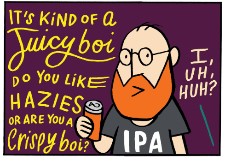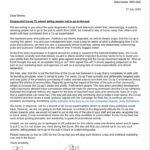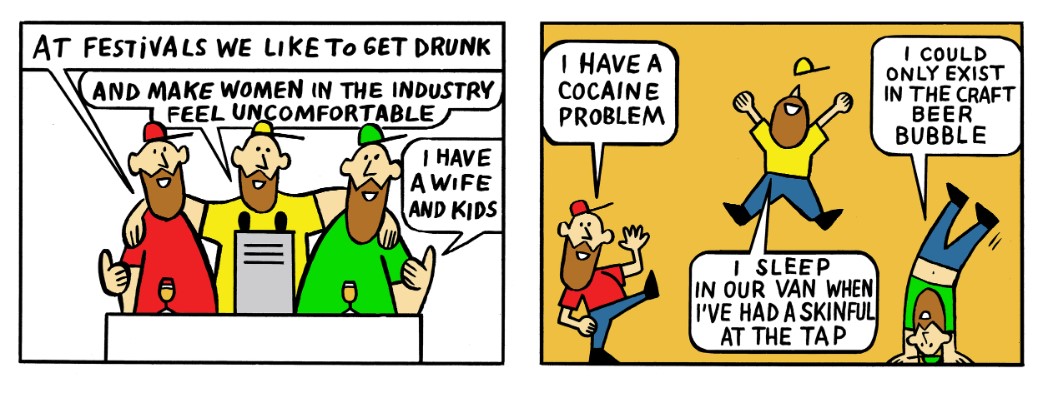 September. The grapes are ripening. And evenings are cooler. And those nightmares about having to go back to grade 11 math class even though that was 45 years ago are back. The rest of the day, you daydream about college days when you were two months away from having to pass in any classwork. And thoughts turn to sweater vests. Over a white t-shirt… if one’s yuff was from that WHAM / Ferris Bueller era forty years ago.* Labour Day Monday was the end of the humidity around these parts. Evenings are cooler. Sweater weather.
September. The grapes are ripening. And evenings are cooler. And those nightmares about having to go back to grade 11 math class even though that was 45 years ago are back. The rest of the day, you daydream about college days when you were two months away from having to pass in any classwork. And thoughts turn to sweater vests. Over a white t-shirt… if one’s yuff was from that WHAM / Ferris Bueller era forty years ago.* Labour Day Monday was the end of the humidity around these parts. Evenings are cooler. Sweater weather.
First up, in the unending ping-pong game of whether alcohol is good for you or bad for you, Drinks Business summaried the powerful and damning critique of Prof. David Spiegelhalter of Cambridge University appeaing of the BBC’s World Service The Food Chain programme:
He said that statistically the overall risk of one beer or wine per day on your life expectancy — which is within current UK government guidelines — has no higher impact than driving a car or eating bacon. Spiegelhalter said that research showed the health benefits of drinking in small amounts, as previously highlighted by the drinks business. He added: “Frankly, I get irritated when the harms of low levels are exaggerated, particularly with claims such as ‘no level of alcohol is safe’. For a start I don’t think the evidence supports that, but also there’s no safe level of driving, there’s no safe level of living, but no one recommends abstention.”
Much, of course, turns on the fuzzy concept of “safe” given that these sorts of statements do not characterize the degree of safety that is, you know… safe. It’s a form of argument that would make the evangelical at the door proud. Fortunately, at least one solid opinion is shared. Spiegelhalter “described the current NHS guidance on levels as ‘ideal’ .” That being… David Morrison, data-driven wine blogger at The Wine Gourd makes a detailed and well footnoted argument against WHO guidance which unfortunately starts with that sad car driving safety analogy (yes, there is a warning… it is called the licensing process) but then making a good recovery:
…as Robert Joseph has noted: ‘we need to promote the unique, historic qualities of wine that make it such a great convivial product and such a delicious partner to food.’ That is, in the words of Erik Skovenborg, we need to note: Wine as part of a healthy lifestyle; and Drinking with friends: wine’s role as a social lubricant. If the wine label has to list the risks (as is being suggested for the new USA guidelines), should it also list the benefits?
And there was much talk in the UK is about the new government’s plan to enforce a ban on smoking in beer gardens and on pub patios. The Independent discusses the implications:
If implemented, the outdoor smoking ban would make it an offence for people to smoke in certain spaces such as pub gardens or outside sports venues. Should it be enforced in the same way as the 2007 indoor smoking ban, smoking in certain outdoor spaces would carry a Fixed Penalty Notice of up to £150. If you refuse to pay this, you are liable to be prosecuted. According to Action on Smoking Health (ASH), the 2007 ban led to a 2.4 percent reduction in hospital admissions for heart attacks, and a 12.3 percent reduction in admissions for childhood asthma.
This is something we have had this sort of ban in Ontario for quite a number of years now – and we’ve expanded it over time – with the result that no one misses breathing in the neighbouring table’s ciggie gak. But these things are local. Apparently elsewhere, not so gak. The Guardian covers some of the frustrations with the proposal:
…Sean Short, 54, was smoking on the pavement outside a Wetherspoon’s pub – there is some suggestion that pavements outside venues could also fall under a new ban. “I think it’s ridiculous. As if there’s not enough pubs being closed anyway at the minute,” he said. “I can understand them banning it outside hospitals, that makes sense, but not outside pubs.” He said an outdoor ban would not stop him from coming to the pub, but he could see that it would for other people, especially when alcohol is cheaper to buy in supermarkets.
Still, will any of this matter if, as The Guardian also asks, the kids ain’t even drinking the stuff:
A seemingly endless stream of recent reports have warned that baby boomers, who have fueled the industry, are retiring and spending less, and millennials aren’t picking up the slack. “You’re looking at a cliff,” the industry analyst Rob McMillan told the San Francisco Chronicle in 2022, following a key report that showed wine consumption in the US hadn’t grown in 2021 – despite bars and restaurants reopening. McMillan foresaw wine consumption by volume declining 20% in the next decade, with millennial habits key to the shift. Last year, Nielsen data showed 45% of gen Zers over 21 said they had never drunk alcohol.
Not all that relatedly, Jordan has been doing his annual stint at the Canadian National Exhibition – aka the CNE – selling beer tokens in a booth, acting as huckster to both carnies and marks alike. Observations include: (i) “Big Boi didn’t draw the crowds”; (ii) a pickle shot is “a pickle, cored out, filled with tequila”; and (iii) someone asked “What is tokens?”
Note: Gary is not linking over at Twex anymore so keep and eye on hiblog for updates. This week he explains why some Canadian troops in WW2 fighting in Italy drank British beer while some of the British fighting there drank Canadian beer.
 Boak and Bailey in their footnotes posed a question about the cartoon in Pellicle last Friday:
Boak and Bailey in their footnotes posed a question about the cartoon in Pellicle last Friday:
…cartoonist David Bailey seems to be arguing that confusion, jargon, and being pushed around by expert staff, is part of the fun of artisanal drinks. But maybe he’s also asking: really? Is that how you want it?
Me, I took the cartoon as pure mockery. I felt badly for the poor beer buyer, there in her tiny version of Pilgrim’s Progress facing the craft carny. Could it be that the craft carney stuff is also off putting… or mid… from the perspective of Gen Zers?
Never mid, Ron introduced me to a new word this week… no, not that sort of word, a brewing related word:
… what’s odd, is that there isn’t a full fermentation record for the “Double Stout”. Just one or two entrie. While there is a full record for Single Stout, right up to racking. Why would that be? Eventually I twigged. There’s a reason there isn’t a full fermentation record. Because that wort wasn’t fully fermented. At least not on its own. I’m pretty sure that this is “heading”. One of the elements of Irish Stout. It’s a strong wort in a high degree of fermentation which was blended in at racking or packaging time. It’s effectively a sort of Kräusen.
Now, I had understand that certain Irish stout had a lesser portion of stale for tang as well as fresher for the body in a blend so, if Ron is listening, does this mean that three different agings including a heading as part of finishing were used? Or am I, as per, wrong?
Laura Hanland posts an interesting set of questions which popped to mind after a certain sort of restaurant experience:
In essence then, my food was deeply “not too bad” – usually enough for me to decide not to return for a repeat visit – but I loved the restaurant so much that I really think I am going to go back and give their pasta a go! And this is my conundrum. If you’re reviewing food, then the food must be good. Surely? But the lovely team, the genial surroundings… these were charming elements that I couldn’t ignore. Also I was a little bit taken by the scowling Italian elder who peered out at me from the kitchen. He gave the whole thing a very authentic feel of a family business. This review makes no sense. I don’t know if it will help you decide whether to visit or not. But I’ll be sure to tell you if I do get back for the pasta.
I think it makes perfect sense. One of the problems in the social media age with its instantly curated expertise (just add water… or, as with the craft carney, booze) is the expectation of mind blowing experiences. They rarely actually happen. For example, my chicken burger was actually a bit bland when we were out this week. Could have done with some chopped green onion in there. Or something. But the server was great as was the sharable carrot cake dessert. Look for the good in things. And put a little black pepper on the burger yourself. Don’t be lazy.
Pellicle‘s feature this week is by Jacob Smith – a discussion with and of the definitely not lazy Judith Gillies, co-founder of Cairn o’ Mohr, a Scottish producer of fruit wines and ciders:
There was little money to spare—Judith fondly recalls a cupboard acting as their only shop—yet, the couple enjoyed something far more valuable than excess cash: access to some of the country’s best fruit. Thanks to its loamy soils, moderate temperatures and—for Scotland—dryish weather, Perthshire is home to an array of world class berries, apples and flowers. As head of production at Cairn o’ Mohr, Judith puts this bounty to good work, producing around 18 different wines, three alcohol-free beverages and five ciders. While popular fruits like strawberries, brambles and raspberries are central figures in several of Cairn o’ Mohr’s wines, less appreciated ingredients like elderberries, oak leaf and gorse are just as commonly used.
I like this line, too: “We tend to take knobbly fruit,” Judith says. “The ones that are too big, too small, too ripe for the supermarkets, things like that.” And speaking of seeking out new tipples, Jancis R reported from a tasting of independent wineries from 15 central and eastern European nations:
Of the other countries whose wines I tasted, Croatia was the most stimulating. The wines, especially those from Istria in the far north of the country, seemed to have an extra layer of sophistication. The region’s special white-wine grape Malvazija Istarska (nothing to do with most other Malvasias) produces full-bodied wines with an apple-skin character, real grip and ageing potential. My favourite examples at the tasting were made, respectively, by the well-established Kozlović winery and the much younger enterprise owned by the unfortunately named Fakin family.
Beating us to EuroEast for drinks, The Beer Nut has been reporting live from Bulgaria this week. It sounds so good:
80% of being on holiday is a random bottle of something that’s €8 in a supermarket and has a picture of a fruit on the label. To my veins, please. Directly… The next song will be performed by a man who looks like he should be on the sex offenders’ register but has sufficient connections to have avoided it… This open-air bar is opposite my hotel. On beautiful sunny days I’ve been looking across and thinking it would be nice for a drink. Here I am and my beer tastes like it was triple-filtered through a skunk’s anal gland…
And for Labo(u)r Day, Dave Infante in VinePair was fairly free with the finger pointery over craft beer’s record in labo(u)r relations:
Substandard products, dangerous equipment failures, hell, even terrible rebrands — workers can help owners solve these problems with union training programs, higher self-enforced safety standards, and honest feedback from outside the boardroom bubble. But they need a voice on the job, and protection to use it even when it’s going to piss the boss off. This industry is getting left behind by drinkers. It cannot afford to be left behind by its workers at the same time. Like the Teamsters organizer at Stone this past Monday, I have a message to deliver this Labor Day weekend. This one is for brewery bosses and workers alike. The country is changing, and so is this industry. Which side are you on?
I know what side I am on when it comes to beer cocktails (because port and stout is not a beer cocktail… even though I called it just that in 2012) but the National Post shared a very extended article on beer cocktails that lingered over something from the 1990s built around a recollection of youth as part of creating the argument that one should not overthink… or even, really, think about these matters:
…Dad mentioned that I’d left some beer in the basement fridge that I might want to take home to drink. Investigation revealed that the bottles in question were the remainders of a six-pack of Tequiza. Some of you may recall this late-’90s-era beer brand, juiced with “the natural flavour of lime” and sweetened with agave nectar, a brand that lots of people in flannel shirts and Doc Martens used to consume while listening to Pearl Jam and waiting for our dial-up modems to connect to the internet. The portmanteau name was supposed to suggest a marriage of tequila and cerveza…
Never thought Tequiza would get that much media footprint but there you go. Finally and definitely in the Tequiza zone, today is the day here in Ontario when I can walk to the corner store and get beer… probably a macro brand I don’t want and at a higher price than elsewhere. But I can get it at 7 am. So that is excellent. Does this mean death to the near century old macro brewers’s run retail monopoly aka “The Beer Store”? Can you say supply chain?
“Bring it on — we’re ready,” Roy Benin, president of The Beer Store, said in a statement. “We see this as a new chapter for The Beer Store and we’re excited to compete. All of our channels – from distribution to retail to deposit return will continue to deliver for Ontario.” The beer conglomerate said it has also expanded its distribution fleet, helping to bring close to 4,000 convenience stores online to sell beer. The retail giant is involved behind the scenes in stocking many of those locations, and grocery stores, as well as its own storefronts.
That being the case – is The Polk right? Is it all politics and money?
It’s not about access. It’s about Dougie needing more bread & circuses distractions for the low information voter to drive more votes his way when he calls the election. He wants to get into another majority before the RCMP gets deeper into the Greenbelt. He’s gonna win, too…
Maybe. Maaaaaybe. Hmm. In the meantime, if you want to keep up with the news before next Thursday? Check out Boak and Bailey every Saturday and Stan back each Monday. Elsewhere go look at then listen to Lew’s podcast. And get your emailed issue of Episodes of my Pub Life by this year’s model citizen David Jesudason on the odd Fridays. And Phil Mellows is at the BritishBeerBreaks. Once a month, Will Hawkes issues his London Beer City newsletter and do sign up for Katie’s now revitalised and wonderful newsletter, The Gulp, too. Ben’s Beer and Badword is back with all the sweary Mary he can think of! And check out the Atlantic Canada Beer Blog‘s weekly roundup. There is new reading at The Glass which is going back to being a blog in this weeks best medium as message news. Any more? Yes! Check to see the highly recommended Beer Ladies Podcast. That’s quite good. And the BOAS podcast for the bro-ly. And the long standing Beervana podcast …except they have now stood down. Plus We Are Beer People. The Boys Are From Märzen podcast appears suspended as does BeerEdge, too. But not Ontario’s own A Quick Beer. There is more from DaftAboutCraft‘s podcast, too. All About Beer has introduced a few podcasts… but some may be losing steam… until… Lew’s interview! And there’s also The Perfect Pour. Plus follow the venerable Full Pint podcast. And the Craft Beer Channel on Youtube. The Moon Under Water… is gone which is not surprising as the ask was $10 a month. Pete Brown’s costs a fifth of that but is writing for 47 readers over there. There was also the Beer O’clock Show but that was gone after a ten year run but returned renewed and here is the link! Errr… nope, it is gone again.
*Ahh… we the drifty, Gen Xers in the era of the X: “What are you interested in?” “Nothing.” “Me neither.“
**Me, I’m all avout the social medias. Facebook still in first (given especially as it is focused on my 300 closest friends and family) then we have BlueSky (166) rising up to maybe… probably… likely pass Mastodon (931) in value… then the seemingly doomed trashy Twex (4,466) hovering somewhere well above my largely ignored Instagram (160), crap Threads (52) with Substack Notes (1) really dragging up the rear.

















